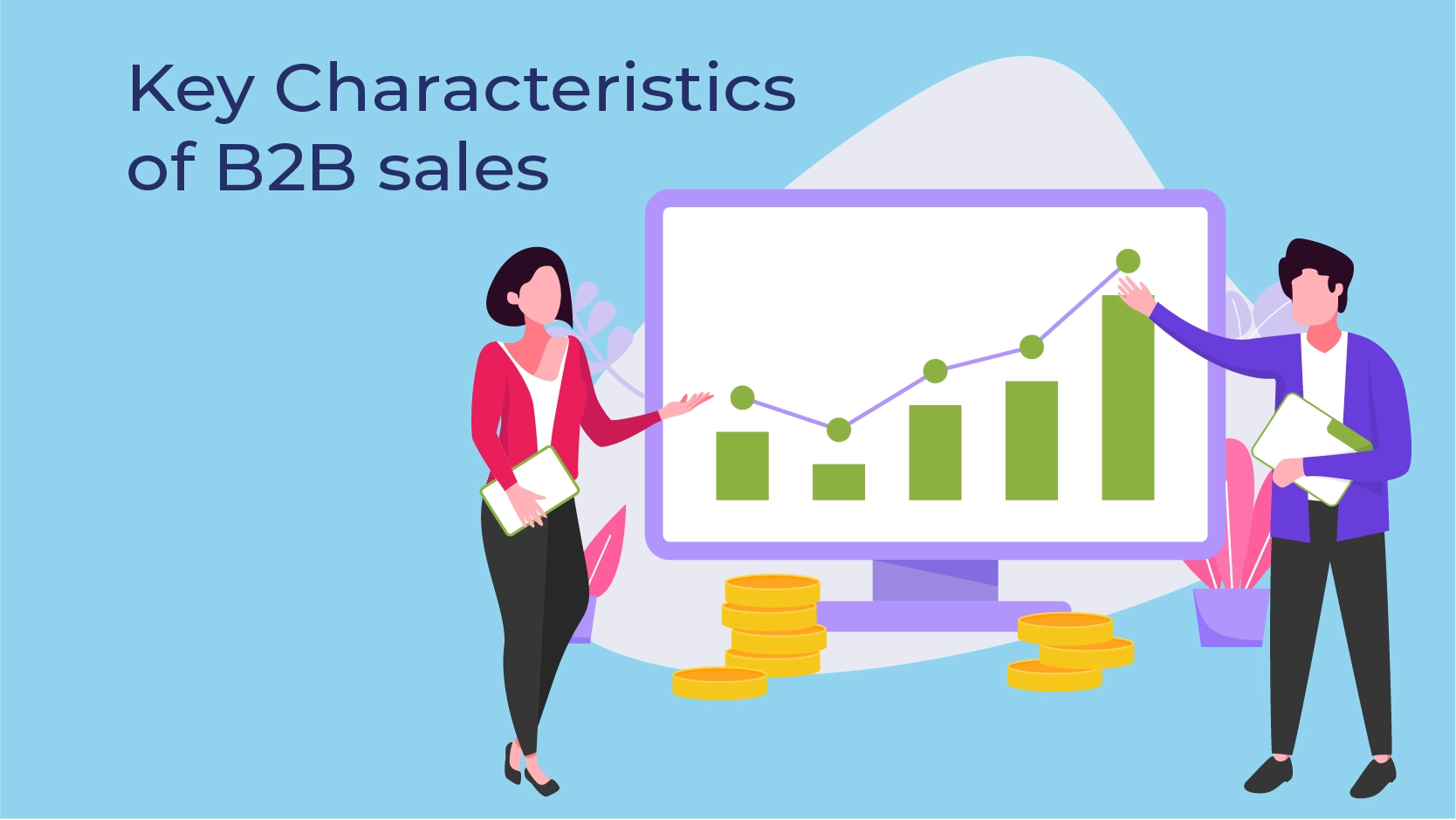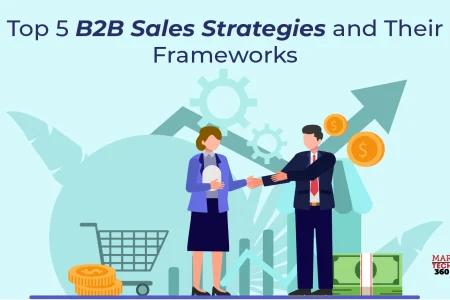In August 2024, 431,928 new business applications were registered in the United States, projecting a 2.5% increase compared to the numbers in July 2024. As consumers are overwhelmed by the options available, it has become challenging for businesses to convert prospects into customers, particularly for B2B organizations. A few B2B sales teams are unable to detect their sales cycle bottlenecks and are repeating their mistakes, which makes the matter even worse. Here is a playbook for all the B2B sales leaders to develop an effective sales cycle that promises higher conversion rates.
What is B2B sales?
Business-to-business (B2B) sales refers to the process of selling products and services to another company or B2B buyers. B2B sales cycles are usually longer and more complicated because they include pitches, negotiations, product demos, and presentations with various decision-makers or stakeholders. B2B sales have various common traits that form the foundation of effective sales approaches.
Key Characteristics of B2B sales

● Higher Ticket Size Or Recurring Revenue Models
One single B2B sales transaction can rake millions of dollars for businesses. Enterprises invest in products and services for a long time because there is a significant amount of cost and time required to replace an existing product or service.
● Involvement of Various Decision makers
Business stakeholders have distinctive goals, needs, and objectives for the transaction. The decision-makers range from mid-level managers to C-suite executives and all the way up to the board members.
Given the above characteristics, B2B sales cycles are time-consuming and intricate. In this blog, We have compiled a list of the best sales strategies and their framework to enhance the sales process.
Also Read: Unveiling The Future of Lead Generation
5 Best B2B Sales Strategies and Their Frameworks
Here are a few top strategies that will help B2B businesses build an effective sales cycle:
1. Keep The Customer at The Center of Growth
Clients should always be at the heart of any sales process to ensure success. The following framework will help organizations to keep clients at the center.
● Personalize the Content and Marketing Efforts
Various organizations are drifting away from a one-size-fits-all marketing approach to adopt a bespoke one tailored to meet the decision-maker’s needs. Clients today expect simpler, on-demand, multi-channel engagement with bespoke interactions. According to the 2022 Gartner Customer Service and Support Survey, approximately 86% of clients expect enterprises to be well-informed about their personal details during an interaction. They expect the clients to offer their expertise, understand their needs precisely, and provide value to their processes.
● Embrace a Customer-Centric Mindset
Organizations should change their focus from internal sales-centric language to a customer-centric approach. Sales leaders should consider prioritizing stages such as awareness, evaluation, and purchase. The key to successful sales is to leverage holistic data to find, lure, and delight clients by customizing their purchase journey.
● Focus on Customer Success
B2B enterprises are prioritizing developing customer success teams that offer constant support and guidance to ensure that the clients drive maximum value from the products and services. This approach results in deepening the existing relationships with them, minimizing the churn rate, and creating new sales opportunities.
● In-depth Analytics
Leveraging 360-degree insights through data analytics is essential for identifying potential customers. It helps predict client needs and engage them early in the buying process. Top-performing companies are more likely to grow faster by using strong customer analytics.
2. Unshackle the Sales Cycle from the Channel Mindset
● Hybrid Sales has Become The New Normal
The traditional one-channel sales approach has become obsolete. B2B prospects today engage with multiple vendors across different channels like in-person meetings, virtual engagements, and digital self-serve kiosks. Enteprises can consider offering a seamless, intuitive experience throughout all the channels to develop strong client relationships and scale quickly.
● Adapt to Client’s Omnichannel Preferences
The trend of digital and remote interactions has accelerated after the pandemic. Consumers today have various options available to them to interact with the brand. Businesses need to determine the preferred channel used by the customer and engage with them. Sales teams should be agile to adopt hybrid roles that function remotely or in-person depending on the client’s preferences.
● Create a Direct-to-Consumer (DTC) Channel in B2B
A few organizations are seeking DTC strategies to bypass intermediaries to interact directly with the end clients. Businesses that leverage this approach along with analytics and personalization can have improved margins and customer loyalty.
3. Develop a Scalable Sales Engine
Building a scalable sales engine can be a daunting task for the decision-makers as it includes various aspects. The following frameworks will result in a sales engine that scales with the business needs.
● Scalability Through Data and Technology
Companies that want to create high-performing sales engines need to leverage technology and data to consistently repeat and improve their best practices. Embracing the latest technologies such as Metaverse, Augmented Reality (AR) and Virtual Reality (VR) will help businesses to offer immersive purchase experiences. This approach is particularly successful for B2B enterprises as they can simulate the applications of their products and services in real-life scenarios to make a constructive sales pitch.
● Refining Tech Adoption
Various enterprises have a lower adoption rate of sales technology irrespective of huge investments. Companies with successful sales have a streamlined tech stack that prioritizes tools to drive sales outcomes. These organizations focus on better data quality and higher user adoption rates rather than the quantity of tools.
4. Rethink the People Strategy
People are the core factor that drives the sales engine to success. The following strategies can help build a team that ensures success in their sales cycles:
● Attracting and Retaining Talent
One of the key challenges in the B2B sales landscape is talent attrition. Organizations should reconsider their sales talent acquisition strategy to meet the demands of modern selling. Sales leaders should hire those who have analytical, technical, and strategic skillsets rather than just having relationship-building capabilities.
● Training and Development
To have an efficient B2B sales strategy, organizations can integrate analytics-powered training programs and customized learning models. Bespoke training modules depending on the data analytics assist sales reps to enhance their skills, which results in better sales outcomes.
5. Stay Persistent with Change
It is critical for organizations to adopt agile sales cycles that determine the organization’s priorities and adjust to them. Here are a few approaches for businesses to develop a sales culture that is agile to adapt to the priorities of the organization.
● Foster Cultural and Behavioral Change
B2B sales teams should ingrain a culture that is agile enough to embrace continuous learning and development. Sales leaders play a crucial role in driving the transformation by inspiring the team to adapt to the change.
● Develop a Robust Revenue Operations Arm
Sales decision-makers should consider developing a revenue operations team (RevOps). These teams should be cross-functional, including stakeholders across pre-sales, sales, and after-sales, to refine their sales approach depending on the client feedback. The core focus of this team should be on closing the deals. Autonomy and trust within teams, along with clear measurement and tracking, help accelerate change across the organization.
Conclusion
The key to success in selling B2B products and services is to rethink the entire process holistically and optimize the approach over time. As B2B selling is an intricate process, there will be tremendous improvement opportunities. Business decision-makers can integrate tools in their IT infrastructure to evaluate the success of their B2B sales strategies and make necessary changes accordingly. The success of sales ecosystems will depend on how the relationship is with the client. Hence, developing strong and lasting relationships with clients will help organizations ensure business continuity in the long run.

